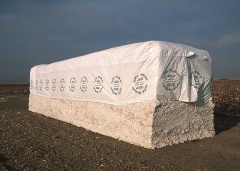Cotton
| Infobox on Cotton | |
|---|---|
| Example of Cotton |  |
| Facts | |
| Origin |
|
| Stowage factor (in m3/t) |
|
| Humidity / moisture |
|
| Oil content | 0.4 - 1.0% (waxes) |
| Ventilation | If the product is loaded for shipment in a dry state, it does not have any particular ventilation requirements. Problems arise if the product, packaging and/or flooring/ceiling are too damp or the temperature is too high. The heat has then to be dissipated and ventilation should proceed as follows: - Air exchange rate: 6 changes/hour (airing) - Moisture must then be eliminated, to reduce mold and bacterial activity. - Since cotton very readily absorbs oxygen, before anybody enters the hold, it must be ventilated and a gas measurement carried out, since a shortage of oxygen may endanger life. |
| Risk factors | Reference is made to the relevant IMO regulations on hazardous cargo. |
Cotton
Contents
Description
Cotton is a soft, fluffy staple fibre that grows in a boll, or protective capsule, around the seeds of cotton plants of the genus Gossypium. The fiber is almost pure cellulose. The botanical purpose of cotton fibre is to aid in seed dispersal.
The plant is a shrub native to tropical and subtropical regions around the world, including the Americas, Africa, and India. The greatest diversity of wild cotton species is found in Mexico, followed by Australia and Africa.
The fibre is most often spun into yarn or thread and used to make a soft, breathable textile.
Cotton is shipped in fully pressed bales, pressed to a considerable density, without harm. Bales vary in size, according to country of origin, in weights between 100 kgs and 330 kgs., and are compressed to varying degrees, strapped by steel bands or wire and covered with cotton, jute or synthetic fibre, and sometimes plastic sheet.
There are four main factors to be considered when purchasing raw cotton:
a) Grade – Cotton is graded by cleanliness or colour. Badly ginned cotton contains more ‘trash’ – dirt, leaf, cut seed, stains, etc., which means higher wastage for the spinner. ‘Stain’ is caused by climatic conditions during growing. Lightning, for instance, will cause a yellow stain on the mature bolls.
b) Staple – The length of the fibres. Evennes of fibre length is an important consideration.
c) Micronaire – A term used to describe the thickness and the maturity of the fibre.
d) Strength – the tenacity of the fibre at breaking point tested by instruments such as Pressley, Stelometer or the High Volume Instrument (HVI).
In addition to the long fibres, cotton also contains cotton-linters. Cotton linters are fine, silky fibres which adhere to the seeds of the cotton plant after ginning. These curly fibres typically are less than 3 mm long. The term also may apply to the longer textile fibre staple lint as well as the shorter fuzzy fibers from some upland species. Linters are traditionally used in the manufacture of paper and as a raw material in the manufacture of cellulose. In the UK, linters are referred to as "cotton wool". This can also be a refined product which has medical, cosmetic and many other practical uses.











